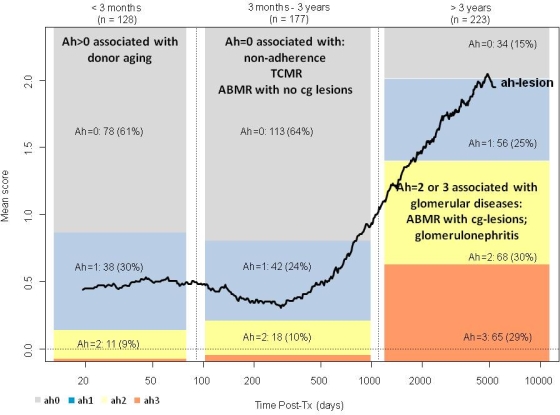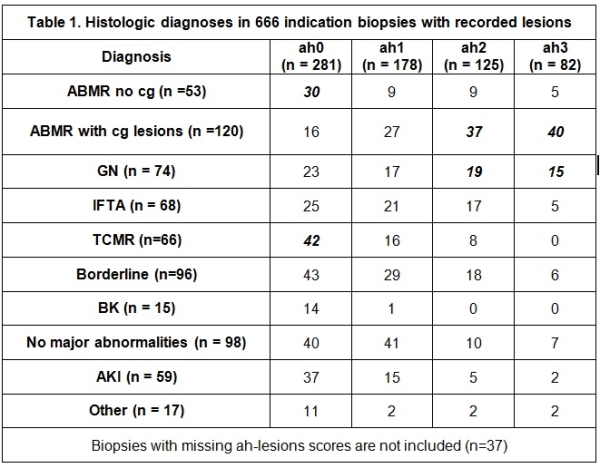Complexity of Hylinosis in Renal Transplant Biopsies: Donor Age, Glomerular Disease, and Time.
1Nephrology, Hannover Medical School, Hannover, Germany
2Alberta Transplant Applied Genomics Centre, Edmonton, Canada
3Department of Medicine, Division of Nephrology and Transplant Immunology, University of Alberta, Edmonton, Canada.
Meeting: 2016 American Transplant Congress
Abstract number: 59
Keywords: Histology
Session Information
Session Name: Concurrent Session: Novel Markers of Long Term Kidney Transplant Outcomes
Session Type: Concurrent Session
Date: Sunday, June 12, 2016
Session Time: 2:30pm-4:00pm
 Presentation Time: 3:18pm-3:30pm
Presentation Time: 3:18pm-3:30pm
Location: Ballroom A
Arteriolar hyalinosis lesions (ah) are often interpreted as a sign of calcineurin inhibitor toxicity even though they are induced by other conditions. We studied the features associated with ah-lesions to understand their relationship to diseases, transcript changes, and outcomes. In indication biopsies from 562 patients (3 days-35 years post-transplant), mean ah-scores increased with time of the biopsy post transplant (TxBx) and correlated with atrophy-fibrosis (r=0.31), but unlike atrophy-scarring, failed to increase until after 500 days (Fig. 1). The associations of ah-lesions varied with TxBx: early (<3 months) donor age; >3 years: progressive glomerular diseases (ABMR with cg lesions or GN) (Table 1). In a multivariable model the independent predictors of ah-score were TxBx (p=6 x10-16); glomerular diseases (p=1×10-11); and donor age (p=0.01). Transcripts had poor associations with ah-lesions but in the early period (<3m) ah-lesions correlated weakly with a blunted injury response e.g. reduced expression of AKI transcript HAVCR2, and increased expression of selected microcirculation transcripts e.g. regulator of G-protein signaling 5 (RGS5). Association of ah with graft failure was complex: risk was high in ah3 but largely due to glomerular diseases. In the 1-5y period, biopsies with ah0 were at risk, due to ABMR without cg lesions, associated with non-adherence. In a multivariable model, Ah-score is a weak predictor of graft survival (p=0.03) compared to ci-score (p=8.6E-07) and TxBx (p=7.1E-05). Hyalinosis in indication biopsies has paradoxical associations. The previous belief that ah3 indicated progressive CNI toxicity may have been due to failure to recognize glomerular disease due to ABMR. 

CITATION INFORMATION: Einecke G, Reeve J, Halloran P. Complexity of Hylinosis in Renal Transplant Biopsies: Donor Age, Glomerular Disease, and Time. Am J Transplant. 2016;16 (suppl 3).
To cite this abstract in AMA style:
Einecke G, Reeve J, Halloran P. Complexity of Hylinosis in Renal Transplant Biopsies: Donor Age, Glomerular Disease, and Time. [abstract]. Am J Transplant. 2016; 16 (suppl 3). https://atcmeetingabstracts.com/abstract/complexity-of-hylinosis-in-renal-transplant-biopsies-donor-age-glomerular-disease-and-time/. Accessed December 17, 2025.« Back to 2016 American Transplant Congress
